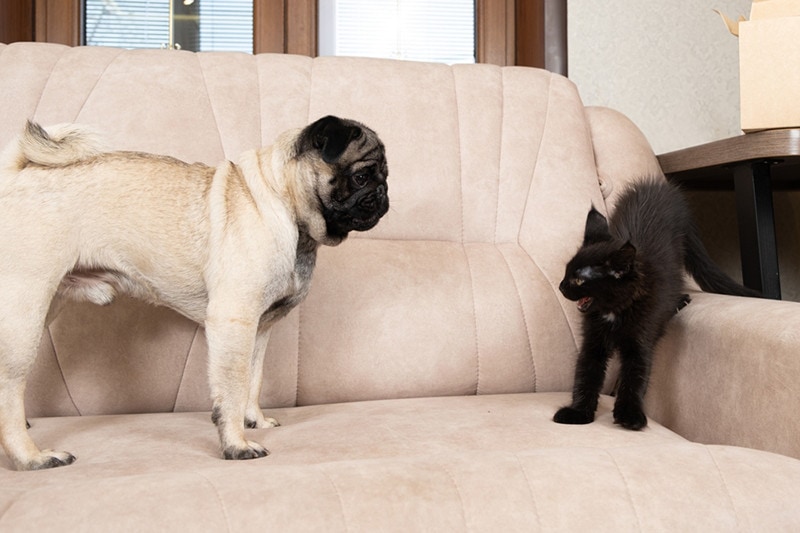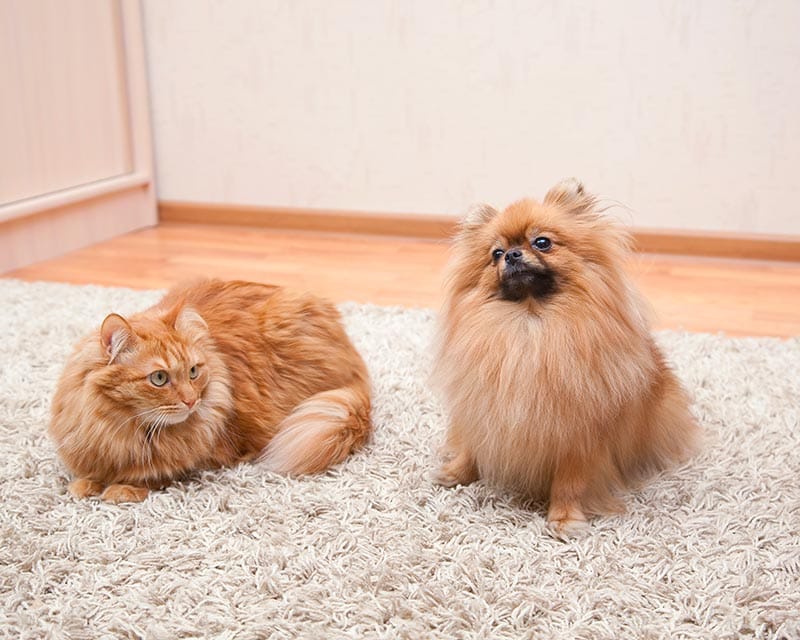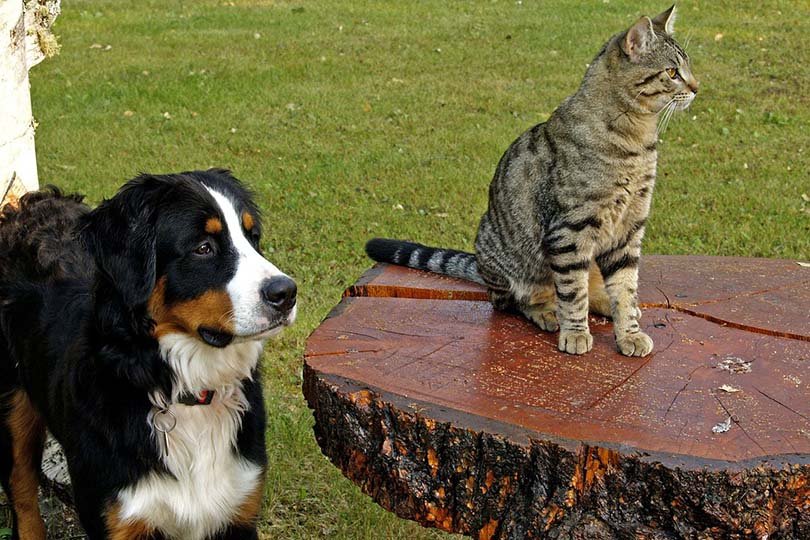When you adopt a new cat or dog, one of the most stressful parts is often introducing them to other members of the family, including your other pets. Often, your cat or dog won’t understand that this new animal is a part of the family. They’re just an intruder!
How you introduce your dog and cat together often has a huge impact on their future relationship. If they are introduced slowly and correctly, they’ll likely learn to at least put up with each other’s presence. If you don’t, you may end up with a dog and a cat that are arch-enemies.
Below, we’ve explained everything you need to know about introducing a dog and a cat together.
The 8 Tips for Introducing a Cat to a Dog
1. Make Your Home Safe
You want your home to be safe for both your cat and your dog. You should provide each animal with a “safe room” that they can utilize whenever they’re feeling unsafe. Each room should have everything your cat and dog need, including a litter box and food bowls. You should also ensure that there isn’t anything dangerous in the pet’s room.
Don’t house your cat with poisonous house plants, for instance.
You should also provide your cat with plenty of tall places to escape to as necessary. They should never be stuck on the floor with your dog, as this can prove to be a dangerous situation.
2. Separate Them
You should start with your pets completely separate. Put them both in their rooms and leave them there. You can allow them to explore the main living area at different times, but they shouldn’t be allowed to see each other at all.
At first, your goal should be to make the new animal comfortable and introduce each animal to the new one’s scent.
You should continue to keep them separate for at least 3 to 4 days.

3. Feed Them “Together”
One moment in the day that any animal associates with happiness is mealtime. Therefore, we’re going to utilize these positive feelings to our advantage.
After your new pet has settled in, start feeding them on opposite sides of a closed door. They will be able to hear and smell each other but not have any physical contact. This setup will keep your cat from feeling threatened, and it will provide a chance for your dog to get used to the cat.
Continue this until both of your pets are completely calm with the process. Preferably, they shouldn’t even pay attention to the door at all.
4. Begin Meetings
The next step is to allow very controlled forms of contact. You can start by letting the dog and cat interact through a cracked door. Doing this right before mealtime is often best, as both animals will be near the door. But, if anything negative takes place, the mealtime will make the experience at least end on a positive note.
Next, put the dog on a leash and allow them into the same room as the cat. Preferably, you should use the main living space for this, not the cat’s room. Let the cat do whatever they want. Reward the dog as they stop paying attention to the cat.
Your goal is to have the dog lying down and being completely calm in the cat’s presence. You don’t even want the dog to act like the cat is there.
Obviously, accomplishing this goal will take multiple attempts. However, the wait is more than worth it.

5. Keep Sessions Short and Sweet
No matter what step you’re on, you should keep the lessons as short as possible. Just 5 minutes is often enough – even less than that if you’re just starting cracked-door introductions.
You don’t want to stress either animal out needlessly, which will likely happen if you let the sessions drag out.
Repeat the sessions daily. Again, you don’t want to use the sessions too much, as this will likely stress the animals out. However, regular contact is important so that you don’t lose any progress. Once a day is often a nice sweet spot to settle in.
6. Be Patient
These beginning steps can take a lot of time. It may take a month for your feline and dog to warm up to each other. If you have a puppy or an untrained dog, this will take even longer. Often, introducing a new cat to an established dog is easier, as then the dog at least has some training.
If you just adopted a dog, be sure to train them while you’re introducing them to your cat. Some simple commands like “stay” and “leave it” can be boons when you’re trying to teach your cat how to interact correctly with your dog.
Group training classes are often extremely helpful, especially since they provide your dog with socialization as well.
Even with training, though, this introduction can take a long time!

7. Allow the Pets Together Freely
Once your dog completely ignores your cat (or at least mostly ignoring your cat), you can drop the leash and allow your dog to walk around the room freely. Don’t unleash them, as you want an easy grab point if the dog decides that the cat is a tasty snack.
If your dog goes after the cat or the cat seems needlessly stressed, go back to an earlier stage and try again. You want each step to be so small that your dog or cat can’t fail. Very tiny steps are the best option here.
If either animal shows tension or stress, then the step wasn’t small enough. Go back and try again.
Having a cat-only room for your feline to escape to and plenty of high areas for them to escape to is particularly important in this stage. If the cat doesn’t feel confident, there is a large possibility that they will run, which will only encourage your dog to chase them.
While much of this article has been focused on the dog, keeping your cat feeling confident is equally important.
8. Proceed Cautiously
You should never allow your dog and cat to be unsupervised together—even if you’ve gone through all of these steps. These animals are very unpredictable. Dogs that have been friends with cats for years may suddenly chase one and seriously harm them.
Therefore, you should always proceed slower than you think you should.
Summing Up
Introducing a cat and dog together often takes a long time. It involves a bunch of very small baby steps. You want to go slower than you probably need to. Going too slow and taking longer is often a better option than going too fast.
If you notice any upset in either animal, go back to an earlier step and try again. If your dog chases your cat or your feline is uncomfortable enough to run, it’s a sign that you moved too fast.
Often, introductions go wrong because the animals are pushed to get along too fast. As long as you go slow, most dogs and cats can get along just fine.
However, some dogs simply have too high of a prey drive to not chase a cat. In these cases, even a perfect introduction can only do so much. If you have a cat, be sure to adopt a dog that can get along with them.
See also:
- How to Introduce a Hyper Dog to a Cat: 12 Important Tips
- Will a Munchkin Cat Get Along With Dogs? Temperament & FAQs
Featured Image Credit: ArtTower, Pixabay











